
Pearl millet is the most widely grown type of millet. It has been grown in Africa and the Indian subcontinent since prehistoric times. The center of diversity, and suggested area of domestication, for the crop is in the Sahel zone of West Africa. Recent archaeobotanical research has confirmed the presence of domesticated pearl millet on the Sahel zone of northern Mali between 2500 and 2000 BC. 2023 was the International Year of Millets, declared by the United Nations General Assembly in 2021.

Cleridae are a family of beetles of the superfamily Cleroidea. They are commonly known as checkered beetles. The family Cleridae has a worldwide distribution, and a variety of habitats and feeding preferences.

Melolonthinae is a subfamily of the scarab beetles. It is a very diverse group; distributed over most of the world, it contains over 11,000 species in over 750 genera. Some authors include the scarab subfamilies Euchirinae and Pachypodinae as tribes in the Melolonthinae.

Maize, also known as corn in North American English, is a tall stout grass that produces cereal grain. It was domesticated by indigenous peoples in southern Mexico about 9,000 years ago from wild teosinte. Native Americans planted it alongside beans and squashes in the Three Sisters polyculture. The leafy stalk of the plant gives rise to male inflorescences or tassels which produce pollen, and female inflorescences called ears. The ears yield grain, known as kernels or seeds. In modern commercial varieties, these are usually yellow or white; other varieties can be of many colors.
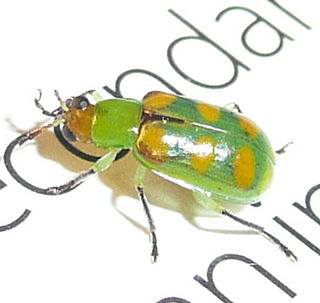
Diabrotica speciosa, also known as the cucurbit beetle and in Spanish as vaquita de San Antonio is an insect pest native to South America. Its larvae feed on the roots of crops. The cucurbit beetle is also known to transmit several viruses such as comoviruses and different mosaic viruses. This is native to South America and is now distributed in Central America and other global areas.

The maize weevil, known in the United States as the greater rice weevil, is a species of beetle in the family Curculionidae. It can be found in numerous tropical areas around the world, and in the United States, and is a major pest of maize. This species attacks both standing crops and stored cereal products, including wheat, rice, sorghum, oats, barley, rye, buckwheat, peas, and cottonseed. The maize weevil also infests other types of stored, processed cereal products such as pasta, cassava, and various coarse, milled grains. It has even been known to attack fruit while in storage, such as apples.

Busseola fusca is a species of moth that is also known as the maize stalk borer. It is known from Ethiopia.
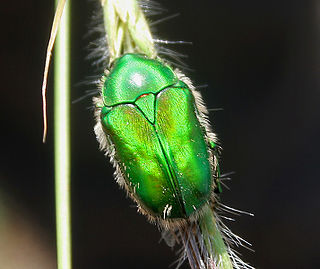
Chiloloba acuta is a species of flower chafer beetle and is the sole member of its genus. It is widely distributed in the Indian subcontinent.

Prostephanus truncatus is commonly referred to as larger grain borer (LGB) with reference to the related Rhyzopertha dominica, which is relatively smaller, and referred to as the lesser grain borer. P. truncatus is about 6 mm (0.24 in) long as compared to 3 mm (0.12 in) long in R. dominica. At optimum conditions of 80% relative humidity and 32 °C (90 °F), and available food, P. truncatus completes its lifecycle within 27 days. It is a serious pest of dried grains, especially maize and dried cassava in West Africa. This beetle is believed to have been introduced into West Africa through food aid from America. It reached Africa through Tanzania in the early 1970s.
Pollen beetle is an informal term for any species of beetle associated intimately with suitably pollen-rich species of flowers. Typically such a beetle is adapted to the pollen as a major part of its diet. Species in at least sixteen families of the order Coleoptera could be counted as pollen beetles, and "pollen beetle" also is a common name for some such species.
Chilo partellus, the spotted stalk borer or spotted stem borer, is a moth in the family Crambidae. It was described by Charles Swinhoe in 1885. It is found in India, Pakistan, Iran, Ethiopia, Lesotho, Madagascar, Malawi, South Africa, Sudan, Tanzania, Uganda and on Mayotte.

Agriotes sputator is a species of click beetle, commonly known as the common click beetle. The adult beetle is brown and inconspicuous, and the larvae live in the soil and are known as wireworms. They are agricultural pests that devour the roots and underground parts of many crops and other plants.
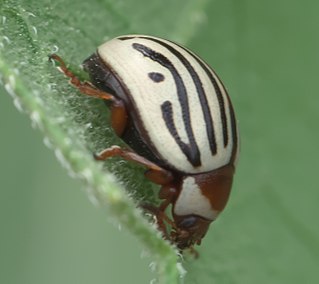
Zygogramma exclamationis, commonly known as the sunflower beetle, is a species of leaf beetle belonging to the family Zygogramma. It is regarded as a pest of sunflower crops in North America.
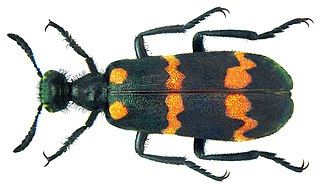
Hycleus pustulatus is a species of blister beetle found in India, Sri Lanka, China and Java.
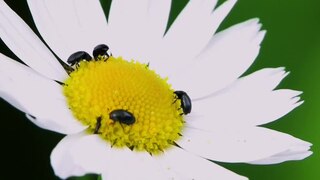
Brassicogethes aeneus, the common pollen beetle, is a species of pollen beetle in the family Nitidulidae. Other common names include the rape pollen beetle and rape blossom beetle. It was previously known as Meligethes aeneus.

Bruchus pisorum, known generally as pea weevil, is a species of leaf beetle in the family Chrysomelidae. Other common names include the pea beetle and pea seed beetle. It is found in Europe and Northern Asia, North America, and temperate Asia.

Hypomeces pulviger, also known as the gold-dust weevil or green weevil, is a species of beetle in the true weevil family. The adult weevil can reach a length of about 14 mm (0.6 in) and is covered with iridescent green or yellowish-green dust-like scales all over the body. This species can be found in India, tropical Southeast Asia, and the Philippines. Both the larvae and adults are crop pests. The larvae live in and pupate in the soil, feeding on living plant roots. The adult weevils are long-lived, doing damage to foliage, and sometimes defoliating young bushes and nursery trees.
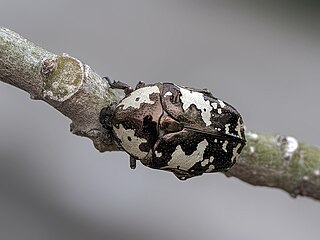
Protaetia aurichalcea is a species of flower-chafer beetle in the family Scarabaeidae. It is found in Asia.

Astylus is a genus of beetles in the family Melyridae. More than 110 species have been described in Astylus. They are found in Central and South America.


















